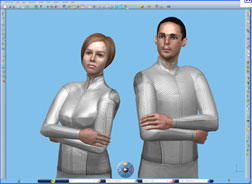|
| Comparative Study of Human Model Constructions in Different 3D Digital Human Modeling Softwares |
Sougata Karmakar,Debkumar Chakrabarti,Indian Institute of Technology Guwahati Kallesh MC,
EDS technologies Pvt. Ltd., Bangalore |
| |
 |
The present day technology for ergonomic evaluation of products and workstations in
the virtual environment is digital human modeling (DHM) and simulation. All the companies which market DHM softwares demand that their product is anatomically and biomechanically most accurate.
Objective: Hence, the present communication focuses on comparative assessment of constructions of digital human models (manikin) by different DHM softwares with special emphasis on the spinal structure.
Design: Three popular DHM softwares namely Jack, Ramsis and Delmia were taken into consideration for this purpose. Manikins of
|
| these 3 softwares were compared in terms of number of body segments and joints; range of movement and degree of freedom of body joints; kinematic control of segmental movements; modes of representation; etc. |
| |
Results: Comparisons revealed that the anatomical and biomechanical characteristics of manikins generated by the 3 softwares under study were significantly different from each other even when they were generated by using same anthropometric database. Moreover, the number of key anthropometric variables needed to define a manikin was found dissimilar. Although, all these 3 softwares represent articulated spinal model, only the Jack software provides movement at each of the 17-moveable segments (thoracic and lumbar). It is worthy to mention that the
bony skeletal system representation mode is only available in the Ramsis software. Due to this unique feature, it is possible to visualize the kinematics of bone
movements during simulated activities.
|
| |
| Conclusions: Following the comparison, it is unwise to select any software as the best one as all these softwares have better qualities in some aspects while it is lacking in some other features. |
| |
| Keywords: Digital human model; Ergonomic evaluation; Spinal model. |
| |
| |